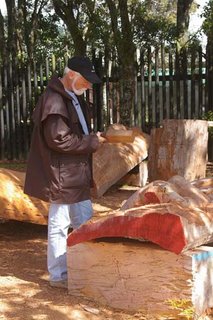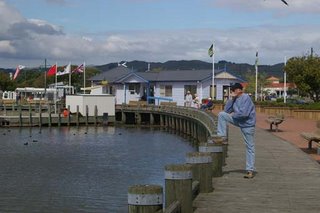Ab-zorb-ing local culture
The scenery that we drove through yesterday was like a child's drawing of a happy day--round green hills dotted with trees, bright blue sky with puffy white clouds and a yellow sun. A typical day in the Waikato region.

We traveled an hour to Rotarua, the site of a still active volcano and thermal region, where hot water and mud constantly percolate through the ground. In order to learn more about New Zealand's Maori people, who came from Polynesia several centuries before the Europeans arrived, we visited the site of New Zealand's largest thermal geyser (over 32 metres),Pohutu, now a centre for Maori culture and art. Our guide took us first to see the geysers, spouting away atop steaming rocks. It's quite a stunning sight--what a natural phenomenon.

 The local Maori people still bathe in these hot spring pools surrounding the geyser. Very relaxing, I imagine, if you can ignore the strong smell of sulphur!
The local Maori people still bathe in these hot spring pools surrounding the geyser. Very relaxing, I imagine, if you can ignore the strong smell of sulphur!
Next we toured the large room where ten apprentices are learning the traditional carving arts of the Maoris, and learned why the carvings are always distorted--the Maoris believe that to try to imitate exactly what God has made is an insult to God, an indication that they are setting themselves up as gods.

 Later, Frank had a chance to examine the huge salvaged logs of native kauri and rimu trees used for these carvings. It is now illegal to cut down any of these endangered and slow-growing native trees, but thousands were felled during the original clearing of NZ by the European settlers in the early 1800's, and much of the timber is still piled in heaps on old farms--it is this lumber that is used for contemporary Maori carving. Frank also tried a few swings with a Maori carving mallet, though he didn't have access to the chisels. (P.S. like his new Aussie oiled jacket?)
Later, Frank had a chance to examine the huge salvaged logs of native kauri and rimu trees used for these carvings. It is now illegal to cut down any of these endangered and slow-growing native trees, but thousands were felled during the original clearing of NZ by the European settlers in the early 1800's, and much of the timber is still piled in heaps on old farms--it is this lumber that is used for contemporary Maori carving. Frank also tried a few swings with a Maori carving mallet, though he didn't have access to the chisels. (P.S. like his new Aussie oiled jacket?)

Next we were treated to a demonstration of weaving. The original Polynesians brought their custom of shell dance skirts with them, but the climate in NZ is too cold for the shells they traditionally used. Instead, the Maori women devised a way of scraping and drying the large leaves of the local flax plants, which curl into tubes as they dry, to imitate the shells. Amazingly convincing.

 We also visited a kiwi house, kept dark and silent for these shy nocturnal flightless birds, now rarely seen in the wild. They are surprisingly big, almost like a turkey, with really long thin beaks for foraging for bugs in the litter of the forest floor. No photos allowed in the kiwi house, but I'm sure you've all seen pictures of kiwi birds.
We also visited a kiwi house, kept dark and silent for these shy nocturnal flightless birds, now rarely seen in the wild. They are surprisingly big, almost like a turkey, with really long thin beaks for foraging for bugs in the litter of the forest floor. No photos allowed in the kiwi house, but I'm sure you've all seen pictures of kiwi birds. The highlight of the visit was our time in the marae, or community meeting house. The whole tour group stood behind our nominal 'chief' for the day (a young man from Australia who was 'volunteered') while the Maori warrior challenged him in the traditional wero, and offered a fern leaf. Our chief picked up the leaf, signifying our peaceful intentions, and then began a beautiful call and response greeting song between the Maoris on the porch of the marae and our tour guide. We were then all invited to remove our shoes and hats and enter the marae.
 Once everyone was seated, our chief was invited onstage to exchange a hongi with the five men in the Maori troupe. This greeting includes a firm handshake and two gentle nose presses. He was warned beforehand that a third nose press indicated an invitation to marry! The Maori group then began an hour-long performance of a variety of songs and dances, from love ballads to the haka, the intimidating war dance now performed by the NZ All-Blacks rugby team before each game.We learned that the wide eyes and extended tongues are a reference to the ancient Maori cannibal tradition--it's a message to the enemy that the warrior is looking forward to tasting him after his defeat! However, the whole war dance is really intended to scare off the enemy to avoid bloodshed altogether--and, we were told, it usually worked. I can believe it--it's really quite spine-tingling to experience close up.
Once everyone was seated, our chief was invited onstage to exchange a hongi with the five men in the Maori troupe. This greeting includes a firm handshake and two gentle nose presses. He was warned beforehand that a third nose press indicated an invitation to marry! The Maori group then began an hour-long performance of a variety of songs and dances, from love ballads to the haka, the intimidating war dance now performed by the NZ All-Blacks rugby team before each game.We learned that the wide eyes and extended tongues are a reference to the ancient Maori cannibal tradition--it's a message to the enemy that the warrior is looking forward to tasting him after his defeat! However, the whole war dance is really intended to scare off the enemy to avoid bloodshed altogether--and, we were told, it usually worked. I can believe it--it's really quite spine-tingling to experience close up.

One song included the rhythmic tossing of short white sticks, and another included the use of white balls on the end of long cords, swung in intricate patterns by the women to imitate the white heron's flight. Very beautiful, stirring, and memorable.

At the end, the Maoris posed for photos and I snapped this traditional warrior stance.

We found it very encouraging to see the pride of these people in their traditional culture, and that NZ society has made a place for it. In fact, we notice the integration of some Maori culture into mainstream NZ practice--many whites (pakeha) use the all-purpose "Kia ora" greeting in everyday life, for example. Conversations with New Zealanders has opened our eyes to the problems of the Maori (similar to the struggles of Canada's natives with poverty, land loss, alcohol and substance abuse, and illness), and we have encountered white New Zealanders with some pretty negative attitudes, but in general I feel that this country is more advanced than Canada in celebrating and integrating their native people.
After a short visit to the pretty shoreline of Lake Rotarua to watch the seaplanes and jetboats, we headed back to Cambridge.

Along the way, however, we stopped to watch a unique New Zealand 'sport'--zorbing. Those willing to pay $45 for the potentially nauseating experience can roll down a long hill inside a huge inflated, padded plastic ball--a zorb. Kinda like being inside bubble wrap, I guess! Quite a few young people were lined up for the privilege, but we limited ourselves to snapping photos. Why 'zorbing'? Not sure--maybe something about the ball's ability to 'absorb' shocks? To me, it looked eerily like the '70s TV show, The Prisoner, where people were mysteriously swallowed up by huge globes just like these.

Our day was completed by a wonderful roast pork dinner with Judy and Gavin Smith, who live across the street from Chiddingfold Garden. Gavin is a watercolour artist, and we are taking a 2-day painting workshop with him this weekend. Watch this site for results--if they are worth sharing!

1 Comments:
Hmm I love the idea behind this website, very unique.
»
Post a Comment
<< Home